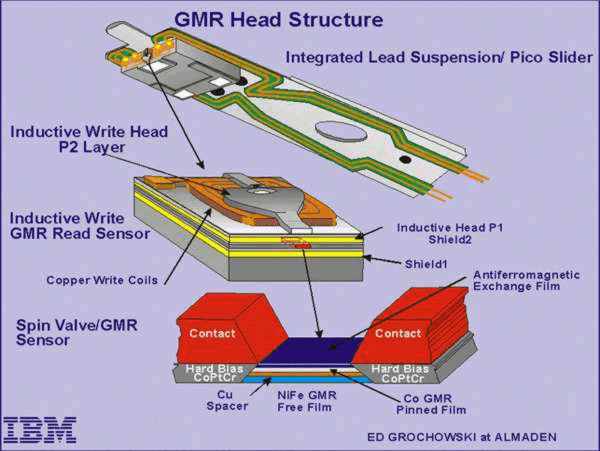| Spintronics |
| Written by Editor | |||||
| Sunday, 30 August 2009 | |||||
Page 2 of 4
Spin valvesAlthough ferromagnetic materials sound as if they belong to the history of computing they are in fact the key to more sophisticated spintronics. An ordinary electric current has its spins set in random directions but by passing the current though a ferromagnetic material only electrons spinning in a particular direction find it easy to pass through. The result is a spin-polarised current and this is what we need to do more advanced spintronics. One of the first practical applications of spin-polarised currents is in the read head of high capacity hard disks. A layer of non-magnetic material is sandwiched between two ferromagnetic layers. The magnetisation of the top layer is fixed or “pinned” in the new jargon of spintronics. As the head travels over the data the recorded 1s and 0s change the magnetisation of the lower layer to be either in the same direction or in the opposite direction as the top or pinned layer. When they are in the same direction the spin-polarised current created by the first passes through the second. When they are in opposite direction the spin-polarised current is blocked by the pinned layer. In effect the resistance of the sandwich of layers is changed by the magnetic field it is in – this is the so-called giant magnetoresistive (GMR) effect which was discovered independently in the late 1980s by two physicists, Albert Fert in France and Peter Grünberg in Germany, who were jointly awarded the 2007 Nobel Prize in Physics. Engineers at IBM's Almaden Research Centre developed GMR into hard disk read heads, called GMR heads. The device is also called a “spin valve” for the obvious reason that the magnetic field turns the current on and off like an open and closed valve. A GMR head assembly A GMR head is much more sensitive to magnetic fields than alternatives and this makes it possible to reduce the size of the magnetic fluctuations on a disk. The use of GMR heads has increased the storage density on a typical hard disk by a factor of three and it’s the main reason we are all using such large capacity hard disks. In addition, GMR chips are now being used in cars and rockets as position and motion sensors. |
|||||
| Last Updated ( Sunday, 30 August 2009 ) |

